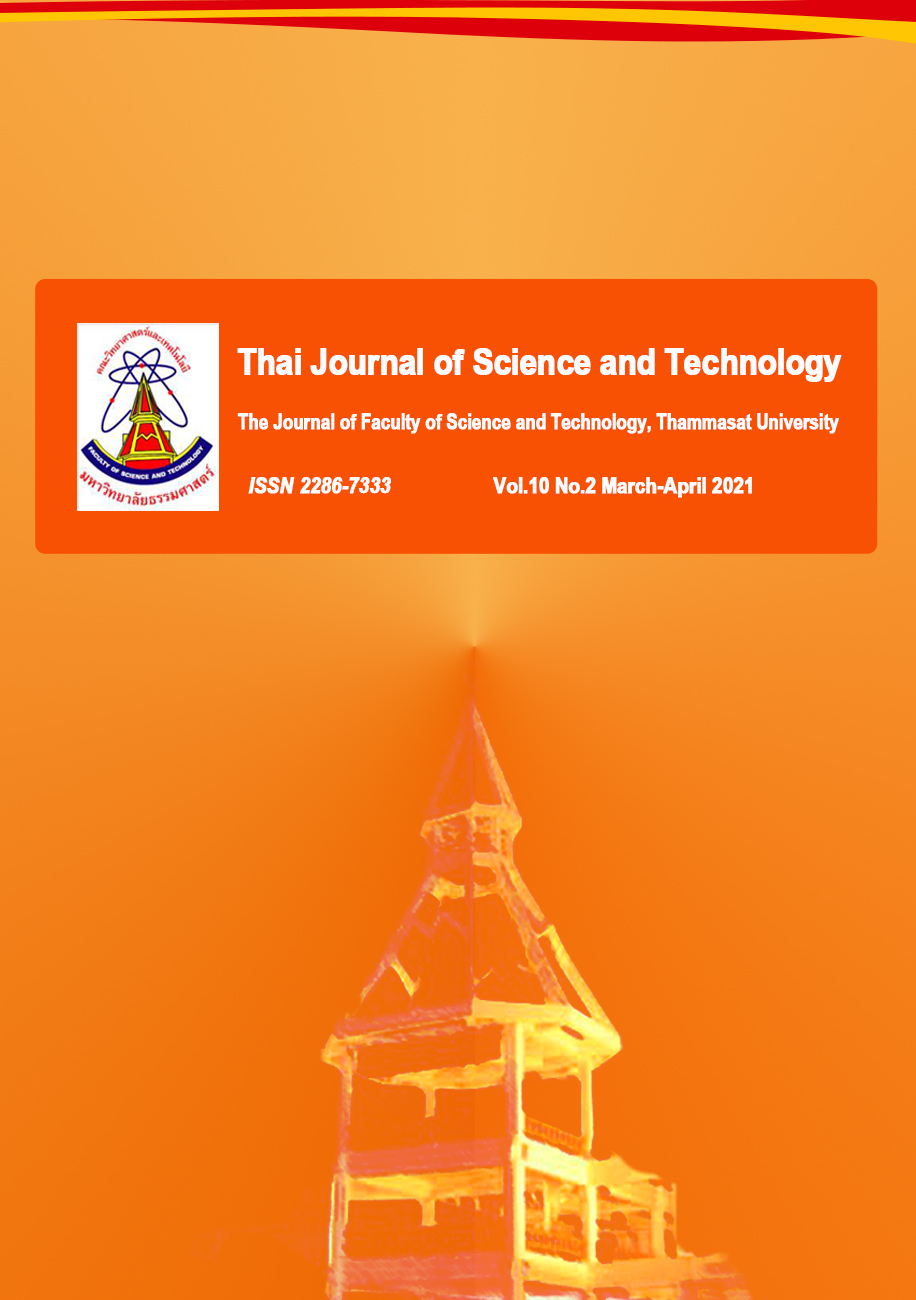An Establishment of Long-Term Culture of Porcine Granulosa Cells and Comparison of DMEM and M199 for Cell Propagation
Main Article Content
Abstract
The result disclosed that in the initiation of the granular cell culture, the cells were round-shaped, then extended and adhered to the surface of the falcon dish. As cultured for 1-2 weeks, they expanded more, and for 12 weeks, turned reticulated. After 12 weeks of culture time in M199, granulosa cells were sub-culture for compared long-term culture based on 2 formulas. The sub-cultured cells were cultured in M199 and DMEM to investigate the morphological characteristics and cell viability of granulosa cells. The result of culturing porcine granulosa cells using M199 compared to those using DMEM, exhibited that, in the beginning, both were round-shaped, and then turned sharp-headed and sharp-bottomed and stretched out. Therein, granulosa cells culture in M199 shows 39.80+4.71% of cell viability, while granulosa cells culture in DMEM shows 116.67+ 8.20% of cell viability. Based on T-test, it is revealed that cell cultures with 2 formulas were statistically significantly different (p<0.05). The advantages of this research are that it enables us to culture porcine granulosa cells efficiently by using both primary cell culture and long-term culture methods in DMEM; that we can study the morphological features, as well as the variances of the cell shapes in the laboratory; and that the cells could be utilized practically in the biotechnological field, thus assisting to economize experiment costs and eliminate animal experiments in accordance with moral norms.
Article Details

This work is licensed under a Creative Commons Attribution-NonCommercial-NoDerivatives 4.0 International License.
บทความที่ได้รับการตีพิมพ์เป็นลิขสิทธิ์ของคณะวิทยาศาสตร์และเทคโนโลยี มหาวิทยาลัยธรรมศาสตร์ ข้อความที่ปรากฏในแต่ละเรื่องของวารสารเล่มนี้เป็นเพียงความเห็นส่วนตัวของผู้เขียน ไม่มีความเกี่ยวข้องกับคณะวิทยาศาสตร์และเทคโนโลยี หรือคณาจารย์ท่านอื่นในมหาวิทยาลัยธรรมศาสตร์ ผู้เขียนต้องยืนยันว่าความรับผิดชอบต่อทุกข้อความที่นำเสนอไว้ในบทความของตน หากมีข้อผิดพลาดหรือความไม่ถูกต้องใด ๆ
References
Alzbeta, F., Martina, S., Jaroslav, M., Josef, D., Martina, R., Stanislav, F., & Daniel, D. (2018). Breast cancer and cancer stem cells: A mini review. Tumori Journal, 100(4), 363-369.
Areekijseree, M., & Vejaratpimol, R. (2006). In vivo and in vitro study of porcine oviductal epithelial cells, cumulus oocyte complexes and granulosa cells: A scanning electron microscopy and inverted microscopy study. Micron, 37(8), 707-716.
Bassols, A., Costa, C., Eckersall, P.D., Osada, J., Sabrià, J., & Tibau, J. (2014). The pig as an animal model for human pathologies: A proteomics perspective. Special Issue: Focus on Animal Models for Translation Proteomics, 8, 715-731.
Chen, J.L., Carta, S., Soldado-Magraner, J., Schneider, B.L., & Helmchen, F. (2013). Behaviour-dependent recruitment of long-range projection neurons in somatosensory cortex. Nature, 499(7458), 336-340.
Cornelia, P.C. (1970). Effect of stage of the estrous cycle and gonadotrophins upon luteinization of porcine granulosa cells in culture. Endocrinology, 87, 156-164.
Hafez, E.S.E. (1992). Reproduction in Farm Animals. Reproductive Toxicology, 8(1), 1-111.
Kumar, A., & Mallick, B.N. (2016). Long-term primary culture of neurons taken from chick embryo brain: A model to study neural cell biology, synaptogenesis, and its dynamic properties. Journal of Neuroscience Methods, 263, 123-133.
Lin, M.T. (2004). Establishment of an immortalized porcine granulosa cell line (PGV) and the study on the potential mechanisms of PGV cell proliferation. The Keio Journal of Medicine, 54, 29-38.
Lossi, L., Carolina, C., Silvia, A., & Adalberto, M. (2016). Ex vivo imaging of active caspase 3 by a FRET-based molecular probe demonstrates the cellular dynamics and localization of the protease in cerebellar granule cells and its regulation by the apoptosis-inhibiting protein surviving. Molecular Neurodegeneration, 11, 11-34.
Miessen, K., Sharbatia, S., Einspaniera, R., & Schoen, J. (2011). Modelling the porcine oviduct epithelium: A polarized in vitro system suitable for long-term cultivation. Theriogenology, 76(5), 900-910.
Pond, K.R., Burns, J.C., & Fisher, D.S. (1987). External markers - Use and methodology in grazing studies. 2nd Grazing Livestock Nutrition Conference, 49-53.
Swindle, M., Makin, M., Herron, A., Clubb, A.J., & Frazier, K.S. (2012). Swine as models in biomedical research and toxicology testing. Veterinary Pathology, 49, 344-356.
Tiemanna, U., Schneidera, F., Vanselowb, J., & Tomeka, W. (2007). In vitro exposure of porcine granulosa cells to the phytoestrogens genistein and daidzein: Effects on the biosynthesis of reproductive steroid hormones. Reproductive Toxicology, 24(3-4), 317-325.
Verbraaka, E.J.C., Velda, M., Koerkampb, G., Roelenc, B.A.J., Haeftena, T.V., Stoorvogela, W., & Zijlstra, C. (2011). Identification of genes targeted by FSH and oocytes in porcine granulosa cells. Theriogenology, 75, 362–376.
Winston, E.T., Alicia, B., Joseph, A.W., Deborah, L., Mosher, Z., Kelly, E.M., & Kelwyn, T. (2001). Characterization of prohibiting in a newly established rat ovarian granulosa cell line. Endocrinology, 142(9), 4076-4085.
Xiaowei, N., Wenjie, S., Duorong, H., Qiuju, L., Ronggen, W., & Yong, T. (2019). Effect of Hyperin and Icariin on steroid hormone secretion in rat ovarian granulosa cells. Clinica Chimica Acta, 495, 646-651.
Yoshinao, O., Hiromasa, O., Takeharu, M., Nobuki, S., Hiroyuki, N., & Koichiro, K. (2012). Dedifferentiated follicular granulosa cells derived from pig ovary can transdifferentiate into osteoblasts. Biochemical Journal, 447(2), 239-248.
Youngsabanant, M., & Rabiab, S. (2020). Potential Effect of porcine follicular fluid (pFF) from Small-, medium-, and large-sized ovarian follicles on HeLa cell line viability. Science, Engineering and Health Studies, 14(1), 141-151.


